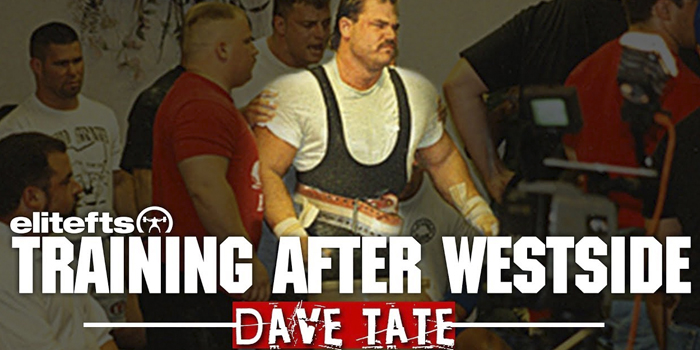Jumbo Shrimp
MuscleChemistry Registered Member
Dave Tate of Elite FtS
[FONT="]
 [/FONT]
[/FONT]
[FONT="] [/FONT]
[/FONT]
[FONT="]There's no question about how Dave Tate trained during his years at Westside: as hard as possible, to lift as much weight as possible. The training at Westside evolved over his period of time training there—and continues to constantly evolve—but was primarily built on the max effort method, dynamic effort method, and repetition effort method. That worked for Dave when he was powerlifting, but what about once he retired from powerlifting and left Westside? In this video, Dave shares the different ways that he has trained since his years as a powerlifter at Westside.[/FONT]
[FONT="]<iframe frameborder="0" height="425" src="https://www.youtube.com/embed/qeC-cUS9evY" width="650" style="box-sizing: border-box; margin: 20px 0px; padding: 0px; border-width: 0px; border-style: initial; font: inherit; vertical-align: baseline; max-width: 100%;"></iframe>[/FONT]
[FONT="]When he first retired, Dave says that he gravitated toward the Doggcrapp style of training, created and popularized by Dante Trudel. Before Dave ever went to Westside, his off-season training was somewhat similar to Doggcrapp training, in that he did HIT training. In those days he would take a week or a month off after a meet, and then go back into training with HIT-style workouts for a while to put on some muscle mass before starting a meet training program again. This appealed to him because he wanted to get in and out quickly while still training hard — which is the same reason he liked Doggcrapp. When he finished his powerlifting career at Westside, it made sense to him to go back to a training style that was efficient, very challenging, and very effective. His main focus in life was going to be building his business, so he wanted a quick and effective workout. Doggcrapp was the answer.[/FONT]
[FONT="]After about six months, though, he missed the conjugate training style — especially the dynamic effort days. He spent some time doing a version of this training style, and thenhe trained with John Meadows. During this time there was some dynamic effort training involved, but it was programmed later in the workouts and wasn't utilized the same way as in Dave's Westside experience. He would often opt out of this explosive work while training with John because, despite being more warmed up later in the workout, he was also more fatigued, especially in the stabilizer muscles. Other than this alteration, this time period of training with John worked great for Dave, mostly because John's training is programmed in waves, uses intensity techniques, and is always very challenging. Dave trained this way for five years.[/FONT]
[FONT="]And then he had his hip replaced. After his hip replacement, when he needed to build strength again, he went right back to what he knows best: the conjugate method.[/FONT]
[FONT="]

[FONT="]
 [/FONT]
[/FONT][FONT="]There's no question about how Dave Tate trained during his years at Westside: as hard as possible, to lift as much weight as possible. The training at Westside evolved over his period of time training there—and continues to constantly evolve—but was primarily built on the max effort method, dynamic effort method, and repetition effort method. That worked for Dave when he was powerlifting, but what about once he retired from powerlifting and left Westside? In this video, Dave shares the different ways that he has trained since his years as a powerlifter at Westside.[/FONT]
[FONT="]<iframe frameborder="0" height="425" src="https://www.youtube.com/embed/qeC-cUS9evY" width="650" style="box-sizing: border-box; margin: 20px 0px; padding: 0px; border-width: 0px; border-style: initial; font: inherit; vertical-align: baseline; max-width: 100%;"></iframe>[/FONT]
[FONT="]When he first retired, Dave says that he gravitated toward the Doggcrapp style of training, created and popularized by Dante Trudel. Before Dave ever went to Westside, his off-season training was somewhat similar to Doggcrapp training, in that he did HIT training. In those days he would take a week or a month off after a meet, and then go back into training with HIT-style workouts for a while to put on some muscle mass before starting a meet training program again. This appealed to him because he wanted to get in and out quickly while still training hard — which is the same reason he liked Doggcrapp. When he finished his powerlifting career at Westside, it made sense to him to go back to a training style that was efficient, very challenging, and very effective. His main focus in life was going to be building his business, so he wanted a quick and effective workout. Doggcrapp was the answer.[/FONT]
[FONT="]After about six months, though, he missed the conjugate training style — especially the dynamic effort days. He spent some time doing a version of this training style, and thenhe trained with John Meadows. During this time there was some dynamic effort training involved, but it was programmed later in the workouts and wasn't utilized the same way as in Dave's Westside experience. He would often opt out of this explosive work while training with John because, despite being more warmed up later in the workout, he was also more fatigued, especially in the stabilizer muscles. Other than this alteration, this time period of training with John worked great for Dave, mostly because John's training is programmed in waves, uses intensity techniques, and is always very challenging. Dave trained this way for five years.[/FONT]
[FONT="]And then he had his hip replaced. After his hip replacement, when he needed to build strength again, he went right back to what he knows best: the conjugate method.[/FONT]



